A Comprehensive Essay on the Importance of Innovation in Companies
VerifiedAdded on 2022/10/14
|7
|2180
|53
Essay
AI Summary
This essay examines the critical importance of innovation in modern companies, emphasizing its role in driving growth, competitiveness, and continuous development. It highlights how innovation helps businesses meet changing customer needs and stand out in the market. The essay also explores the four key components of a creative work environment: freedom and autonomy, risk-taking ability, sufficient time for idea generation, and top management support. It argues that fostering these elements is essential for promoting innovation within an organization. The essay references research and provides insights into how companies can cultivate a culture that embraces new ideas and strategies to ensure long-term success. Finally, it underscores the challenges many organizations face in implementing these components, particularly in balancing productivity with innovative endeavors.
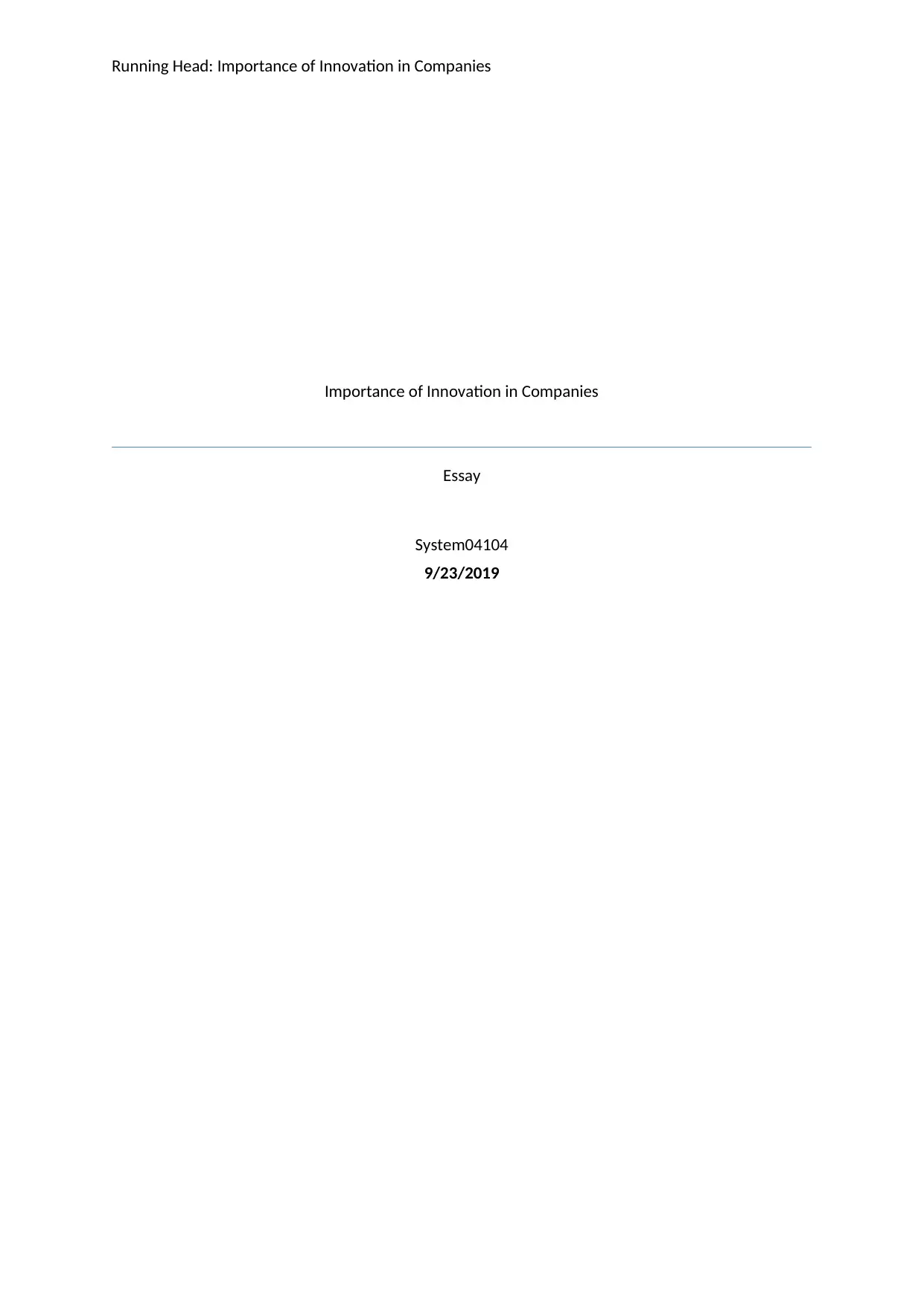
Running Head: Importance of Innovation in Companies
Importance of Innovation in Companies
Essay
System04104
9/23/2019
Importance of Innovation in Companies
Essay
System04104
9/23/2019
Paraphrase This Document
Need a fresh take? Get an instant paraphrase of this document with our AI Paraphraser
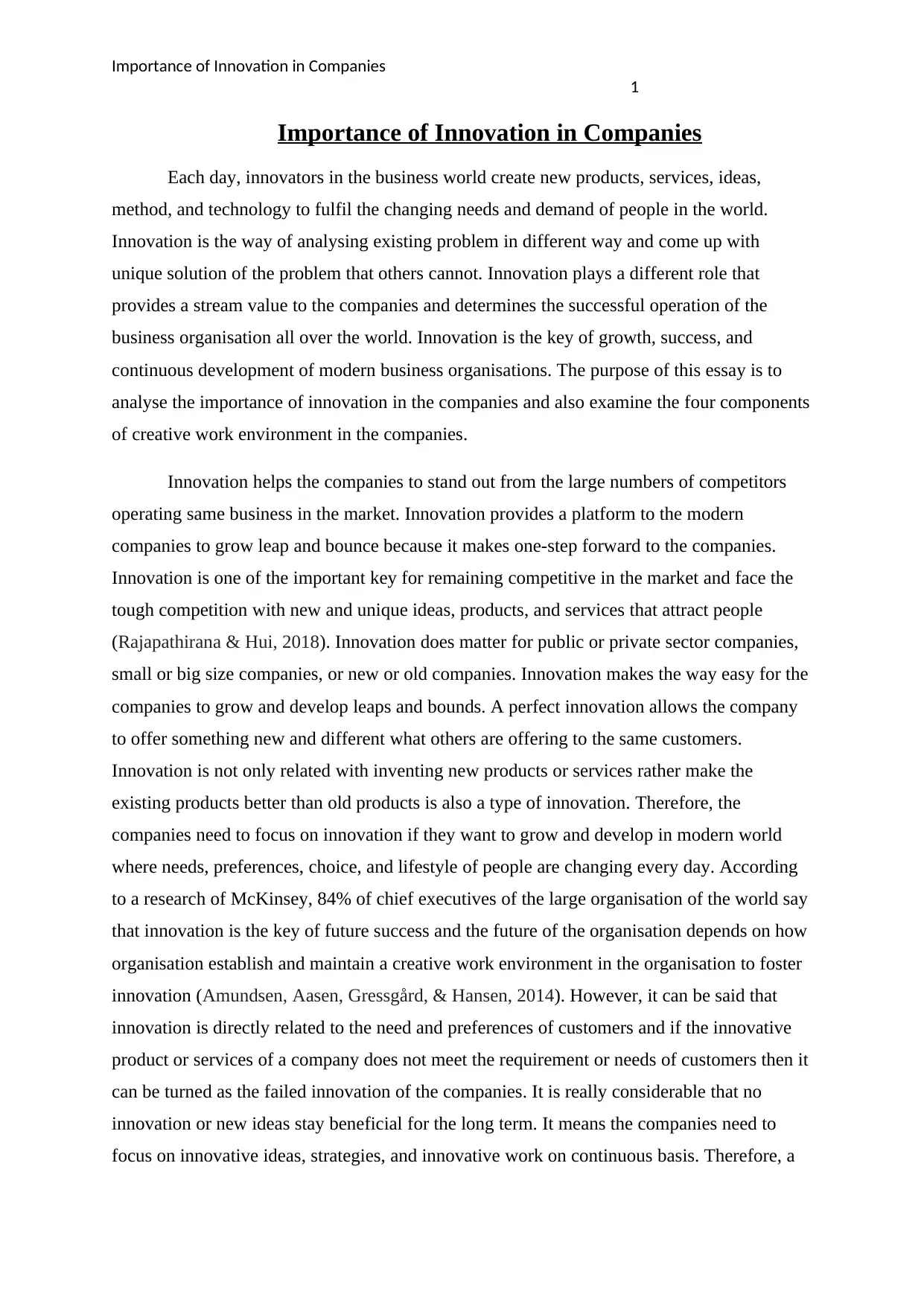
Importance of Innovation in Companies
1
Importance of Innovation in Companies
Each day, innovators in the business world create new products, services, ideas,
method, and technology to fulfil the changing needs and demand of people in the world.
Innovation is the way of analysing existing problem in different way and come up with
unique solution of the problem that others cannot. Innovation plays a different role that
provides a stream value to the companies and determines the successful operation of the
business organisation all over the world. Innovation is the key of growth, success, and
continuous development of modern business organisations. The purpose of this essay is to
analyse the importance of innovation in the companies and also examine the four components
of creative work environment in the companies.
Innovation helps the companies to stand out from the large numbers of competitors
operating same business in the market. Innovation provides a platform to the modern
companies to grow leap and bounce because it makes one-step forward to the companies.
Innovation is one of the important key for remaining competitive in the market and face the
tough competition with new and unique ideas, products, and services that attract people
(Rajapathirana & Hui, 2018). Innovation does matter for public or private sector companies,
small or big size companies, or new or old companies. Innovation makes the way easy for the
companies to grow and develop leaps and bounds. A perfect innovation allows the company
to offer something new and different what others are offering to the same customers.
Innovation is not only related with inventing new products or services rather make the
existing products better than old products is also a type of innovation. Therefore, the
companies need to focus on innovation if they want to grow and develop in modern world
where needs, preferences, choice, and lifestyle of people are changing every day. According
to a research of McKinsey, 84% of chief executives of the large organisation of the world say
that innovation is the key of future success and the future of the organisation depends on how
organisation establish and maintain a creative work environment in the organisation to foster
innovation (Amundsen, Aasen, Gressgård, & Hansen, 2014). However, it can be said that
innovation is directly related to the need and preferences of customers and if the innovative
product or services of a company does not meet the requirement or needs of customers then it
can be turned as the failed innovation of the companies. It is really considerable that no
innovation or new ideas stay beneficial for the long term. It means the companies need to
focus on innovative ideas, strategies, and innovative work on continuous basis. Therefore, a
1
Importance of Innovation in Companies
Each day, innovators in the business world create new products, services, ideas,
method, and technology to fulfil the changing needs and demand of people in the world.
Innovation is the way of analysing existing problem in different way and come up with
unique solution of the problem that others cannot. Innovation plays a different role that
provides a stream value to the companies and determines the successful operation of the
business organisation all over the world. Innovation is the key of growth, success, and
continuous development of modern business organisations. The purpose of this essay is to
analyse the importance of innovation in the companies and also examine the four components
of creative work environment in the companies.
Innovation helps the companies to stand out from the large numbers of competitors
operating same business in the market. Innovation provides a platform to the modern
companies to grow leap and bounce because it makes one-step forward to the companies.
Innovation is one of the important key for remaining competitive in the market and face the
tough competition with new and unique ideas, products, and services that attract people
(Rajapathirana & Hui, 2018). Innovation does matter for public or private sector companies,
small or big size companies, or new or old companies. Innovation makes the way easy for the
companies to grow and develop leaps and bounds. A perfect innovation allows the company
to offer something new and different what others are offering to the same customers.
Innovation is not only related with inventing new products or services rather make the
existing products better than old products is also a type of innovation. Therefore, the
companies need to focus on innovation if they want to grow and develop in modern world
where needs, preferences, choice, and lifestyle of people are changing every day. According
to a research of McKinsey, 84% of chief executives of the large organisation of the world say
that innovation is the key of future success and the future of the organisation depends on how
organisation establish and maintain a creative work environment in the organisation to foster
innovation (Amundsen, Aasen, Gressgård, & Hansen, 2014). However, it can be said that
innovation is directly related to the need and preferences of customers and if the innovative
product or services of a company does not meet the requirement or needs of customers then it
can be turned as the failed innovation of the companies. It is really considerable that no
innovation or new ideas stay beneficial for the long term. It means the companies need to
focus on innovative ideas, strategies, and innovative work on continuous basis. Therefore, a
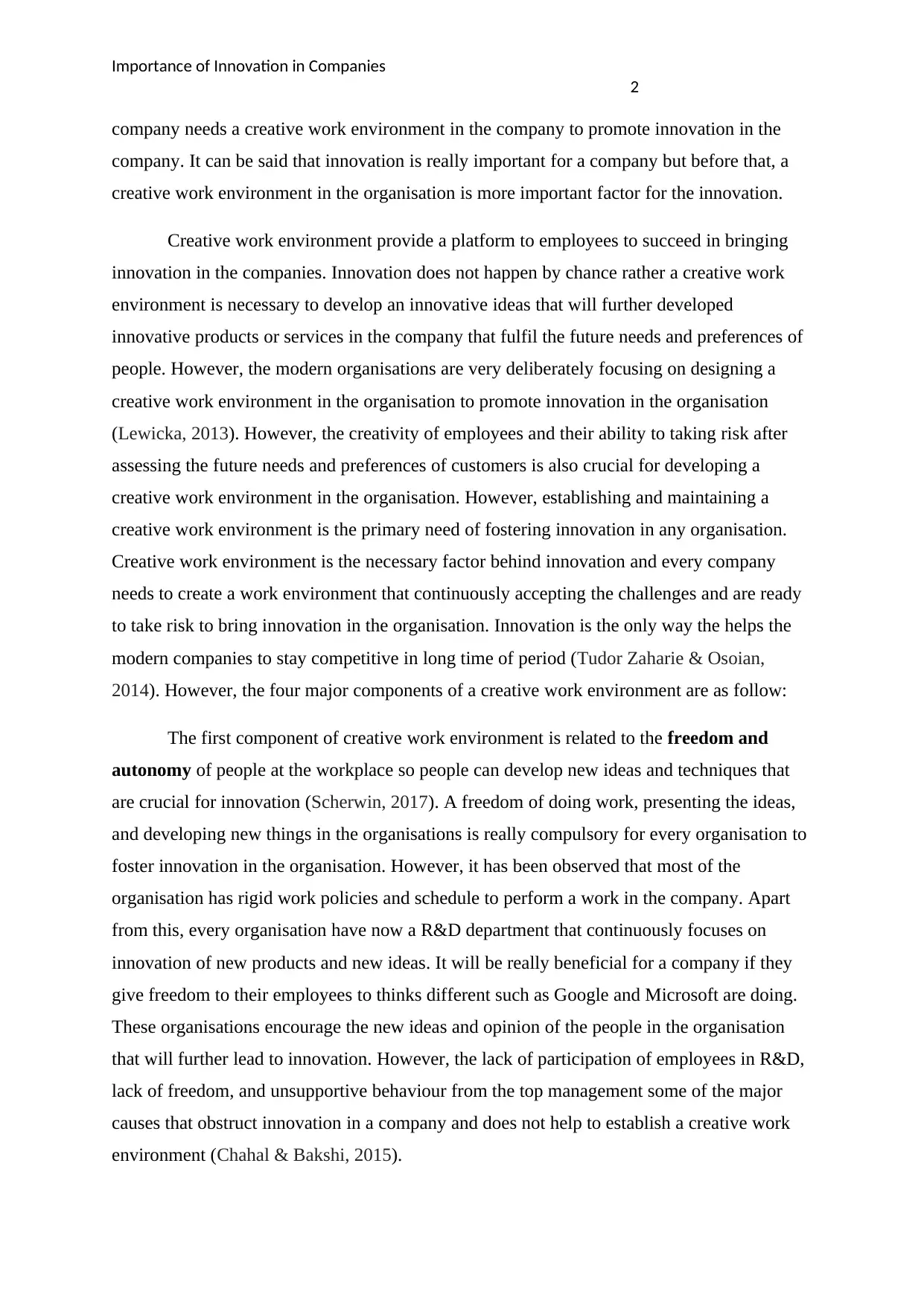
Importance of Innovation in Companies
2
company needs a creative work environment in the company to promote innovation in the
company. It can be said that innovation is really important for a company but before that, a
creative work environment in the organisation is more important factor for the innovation.
Creative work environment provide a platform to employees to succeed in bringing
innovation in the companies. Innovation does not happen by chance rather a creative work
environment is necessary to develop an innovative ideas that will further developed
innovative products or services in the company that fulfil the future needs and preferences of
people. However, the modern organisations are very deliberately focusing on designing a
creative work environment in the organisation to promote innovation in the organisation
(Lewicka, 2013). However, the creativity of employees and their ability to taking risk after
assessing the future needs and preferences of customers is also crucial for developing a
creative work environment in the organisation. However, establishing and maintaining a
creative work environment is the primary need of fostering innovation in any organisation.
Creative work environment is the necessary factor behind innovation and every company
needs to create a work environment that continuously accepting the challenges and are ready
to take risk to bring innovation in the organisation. Innovation is the only way the helps the
modern companies to stay competitive in long time of period (Tudor Zaharie & Osoian,
2014). However, the four major components of a creative work environment are as follow:
The first component of creative work environment is related to the freedom and
autonomy of people at the workplace so people can develop new ideas and techniques that
are crucial for innovation (Scherwin, 2017). A freedom of doing work, presenting the ideas,
and developing new things in the organisations is really compulsory for every organisation to
foster innovation in the organisation. However, it has been observed that most of the
organisation has rigid work policies and schedule to perform a work in the company. Apart
from this, every organisation have now a R&D department that continuously focuses on
innovation of new products and new ideas. It will be really beneficial for a company if they
give freedom to their employees to thinks different such as Google and Microsoft are doing.
These organisations encourage the new ideas and opinion of the people in the organisation
that will further lead to innovation. However, the lack of participation of employees in R&D,
lack of freedom, and unsupportive behaviour from the top management some of the major
causes that obstruct innovation in a company and does not help to establish a creative work
environment (Chahal & Bakshi, 2015).
2
company needs a creative work environment in the company to promote innovation in the
company. It can be said that innovation is really important for a company but before that, a
creative work environment in the organisation is more important factor for the innovation.
Creative work environment provide a platform to employees to succeed in bringing
innovation in the companies. Innovation does not happen by chance rather a creative work
environment is necessary to develop an innovative ideas that will further developed
innovative products or services in the company that fulfil the future needs and preferences of
people. However, the modern organisations are very deliberately focusing on designing a
creative work environment in the organisation to promote innovation in the organisation
(Lewicka, 2013). However, the creativity of employees and their ability to taking risk after
assessing the future needs and preferences of customers is also crucial for developing a
creative work environment in the organisation. However, establishing and maintaining a
creative work environment is the primary need of fostering innovation in any organisation.
Creative work environment is the necessary factor behind innovation and every company
needs to create a work environment that continuously accepting the challenges and are ready
to take risk to bring innovation in the organisation. Innovation is the only way the helps the
modern companies to stay competitive in long time of period (Tudor Zaharie & Osoian,
2014). However, the four major components of a creative work environment are as follow:
The first component of creative work environment is related to the freedom and
autonomy of people at the workplace so people can develop new ideas and techniques that
are crucial for innovation (Scherwin, 2017). A freedom of doing work, presenting the ideas,
and developing new things in the organisations is really compulsory for every organisation to
foster innovation in the organisation. However, it has been observed that most of the
organisation has rigid work policies and schedule to perform a work in the company. Apart
from this, every organisation have now a R&D department that continuously focuses on
innovation of new products and new ideas. It will be really beneficial for a company if they
give freedom to their employees to thinks different such as Google and Microsoft are doing.
These organisations encourage the new ideas and opinion of the people in the organisation
that will further lead to innovation. However, the lack of participation of employees in R&D,
lack of freedom, and unsupportive behaviour from the top management some of the major
causes that obstruct innovation in a company and does not help to establish a creative work
environment (Chahal & Bakshi, 2015).
⊘ This is a preview!⊘
Do you want full access?
Subscribe today to unlock all pages.

Trusted by 1+ million students worldwide
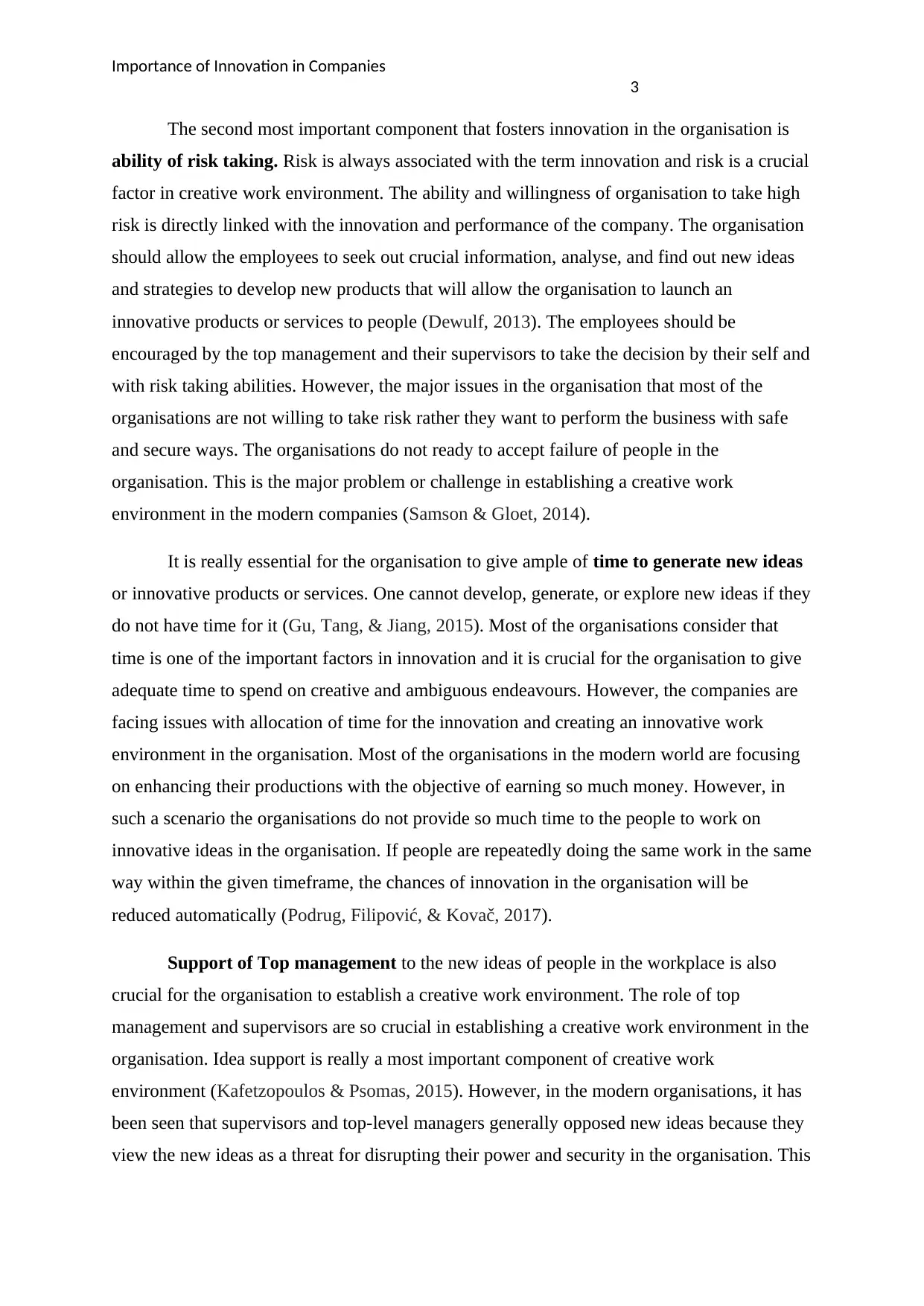
Importance of Innovation in Companies
3
The second most important component that fosters innovation in the organisation is
ability of risk taking. Risk is always associated with the term innovation and risk is a crucial
factor in creative work environment. The ability and willingness of organisation to take high
risk is directly linked with the innovation and performance of the company. The organisation
should allow the employees to seek out crucial information, analyse, and find out new ideas
and strategies to develop new products that will allow the organisation to launch an
innovative products or services to people (Dewulf, 2013). The employees should be
encouraged by the top management and their supervisors to take the decision by their self and
with risk taking abilities. However, the major issues in the organisation that most of the
organisations are not willing to take risk rather they want to perform the business with safe
and secure ways. The organisations do not ready to accept failure of people in the
organisation. This is the major problem or challenge in establishing a creative work
environment in the modern companies (Samson & Gloet, 2014).
It is really essential for the organisation to give ample of time to generate new ideas
or innovative products or services. One cannot develop, generate, or explore new ideas if they
do not have time for it (Gu, Tang, & Jiang, 2015). Most of the organisations consider that
time is one of the important factors in innovation and it is crucial for the organisation to give
adequate time to spend on creative and ambiguous endeavours. However, the companies are
facing issues with allocation of time for the innovation and creating an innovative work
environment in the organisation. Most of the organisations in the modern world are focusing
on enhancing their productions with the objective of earning so much money. However, in
such a scenario the organisations do not provide so much time to the people to work on
innovative ideas in the organisation. If people are repeatedly doing the same work in the same
way within the given timeframe, the chances of innovation in the organisation will be
reduced automatically (Podrug, Filipović, & Kovač, 2017).
Support of Top management to the new ideas of people in the workplace is also
crucial for the organisation to establish a creative work environment. The role of top
management and supervisors are so crucial in establishing a creative work environment in the
organisation. Idea support is really a most important component of creative work
environment (Kafetzopoulos & Psomas, 2015). However, in the modern organisations, it has
been seen that supervisors and top-level managers generally opposed new ideas because they
view the new ideas as a threat for disrupting their power and security in the organisation. This
3
The second most important component that fosters innovation in the organisation is
ability of risk taking. Risk is always associated with the term innovation and risk is a crucial
factor in creative work environment. The ability and willingness of organisation to take high
risk is directly linked with the innovation and performance of the company. The organisation
should allow the employees to seek out crucial information, analyse, and find out new ideas
and strategies to develop new products that will allow the organisation to launch an
innovative products or services to people (Dewulf, 2013). The employees should be
encouraged by the top management and their supervisors to take the decision by their self and
with risk taking abilities. However, the major issues in the organisation that most of the
organisations are not willing to take risk rather they want to perform the business with safe
and secure ways. The organisations do not ready to accept failure of people in the
organisation. This is the major problem or challenge in establishing a creative work
environment in the modern companies (Samson & Gloet, 2014).
It is really essential for the organisation to give ample of time to generate new ideas
or innovative products or services. One cannot develop, generate, or explore new ideas if they
do not have time for it (Gu, Tang, & Jiang, 2015). Most of the organisations consider that
time is one of the important factors in innovation and it is crucial for the organisation to give
adequate time to spend on creative and ambiguous endeavours. However, the companies are
facing issues with allocation of time for the innovation and creating an innovative work
environment in the organisation. Most of the organisations in the modern world are focusing
on enhancing their productions with the objective of earning so much money. However, in
such a scenario the organisations do not provide so much time to the people to work on
innovative ideas in the organisation. If people are repeatedly doing the same work in the same
way within the given timeframe, the chances of innovation in the organisation will be
reduced automatically (Podrug, Filipović, & Kovač, 2017).
Support of Top management to the new ideas of people in the workplace is also
crucial for the organisation to establish a creative work environment. The role of top
management and supervisors are so crucial in establishing a creative work environment in the
organisation. Idea support is really a most important component of creative work
environment (Kafetzopoulos & Psomas, 2015). However, in the modern organisations, it has
been seen that supervisors and top-level managers generally opposed new ideas because they
view the new ideas as a threat for disrupting their power and security in the organisation. This
Paraphrase This Document
Need a fresh take? Get an instant paraphrase of this document with our AI Paraphraser
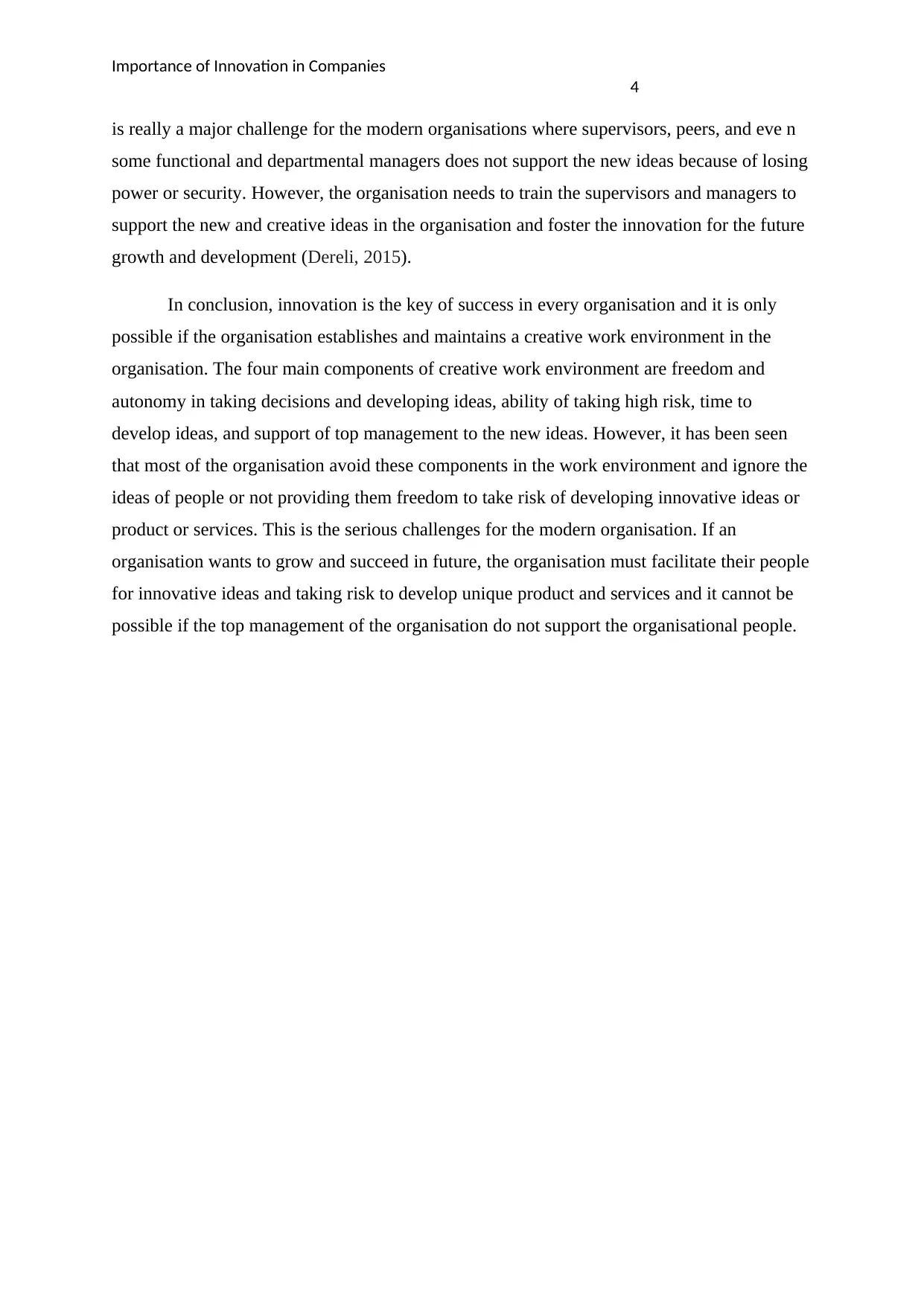
Importance of Innovation in Companies
4
is really a major challenge for the modern organisations where supervisors, peers, and eve n
some functional and departmental managers does not support the new ideas because of losing
power or security. However, the organisation needs to train the supervisors and managers to
support the new and creative ideas in the organisation and foster the innovation for the future
growth and development (Dereli, 2015).
In conclusion, innovation is the key of success in every organisation and it is only
possible if the organisation establishes and maintains a creative work environment in the
organisation. The four main components of creative work environment are freedom and
autonomy in taking decisions and developing ideas, ability of taking high risk, time to
develop ideas, and support of top management to the new ideas. However, it has been seen
that most of the organisation avoid these components in the work environment and ignore the
ideas of people or not providing them freedom to take risk of developing innovative ideas or
product or services. This is the serious challenges for the modern organisation. If an
organisation wants to grow and succeed in future, the organisation must facilitate their people
for innovative ideas and taking risk to develop unique product and services and it cannot be
possible if the top management of the organisation do not support the organisational people.
4
is really a major challenge for the modern organisations where supervisors, peers, and eve n
some functional and departmental managers does not support the new ideas because of losing
power or security. However, the organisation needs to train the supervisors and managers to
support the new and creative ideas in the organisation and foster the innovation for the future
growth and development (Dereli, 2015).
In conclusion, innovation is the key of success in every organisation and it is only
possible if the organisation establishes and maintains a creative work environment in the
organisation. The four main components of creative work environment are freedom and
autonomy in taking decisions and developing ideas, ability of taking high risk, time to
develop ideas, and support of top management to the new ideas. However, it has been seen
that most of the organisation avoid these components in the work environment and ignore the
ideas of people or not providing them freedom to take risk of developing innovative ideas or
product or services. This is the serious challenges for the modern organisation. If an
organisation wants to grow and succeed in future, the organisation must facilitate their people
for innovative ideas and taking risk to develop unique product and services and it cannot be
possible if the top management of the organisation do not support the organisational people.
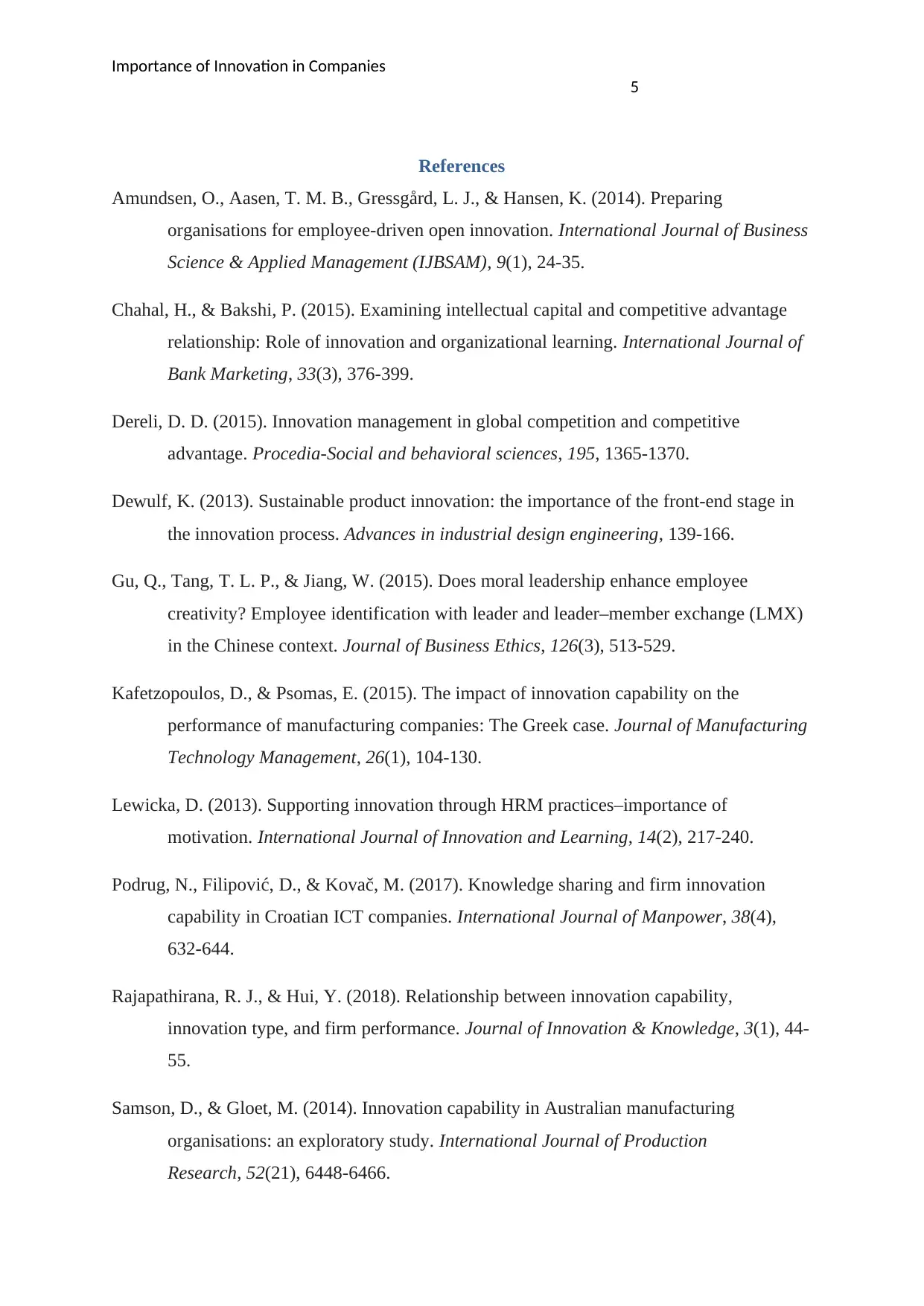
Importance of Innovation in Companies
5
References
Amundsen, O., Aasen, T. M. B., Gressgård, L. J., & Hansen, K. (2014). Preparing
organisations for employee-driven open innovation. International Journal of Business
Science & Applied Management (IJBSAM), 9(1), 24-35.
Chahal, H., & Bakshi, P. (2015). Examining intellectual capital and competitive advantage
relationship: Role of innovation and organizational learning. International Journal of
Bank Marketing, 33(3), 376-399.
Dereli, D. D. (2015). Innovation management in global competition and competitive
advantage. Procedia-Social and behavioral sciences, 195, 1365-1370.
Dewulf, K. (2013). Sustainable product innovation: the importance of the front-end stage in
the innovation process. Advances in industrial design engineering, 139-166.
Gu, Q., Tang, T. L. P., & Jiang, W. (2015). Does moral leadership enhance employee
creativity? Employee identification with leader and leader–member exchange (LMX)
in the Chinese context. Journal of Business Ethics, 126(3), 513-529.
Kafetzopoulos, D., & Psomas, E. (2015). The impact of innovation capability on the
performance of manufacturing companies: The Greek case. Journal of Manufacturing
Technology Management, 26(1), 104-130.
Lewicka, D. (2013). Supporting innovation through HRM practices–importance of
motivation. International Journal of Innovation and Learning, 14(2), 217-240.
Podrug, N., Filipović, D., & Kovač, M. (2017). Knowledge sharing and firm innovation
capability in Croatian ICT companies. International Journal of Manpower, 38(4),
632-644.
Rajapathirana, R. J., & Hui, Y. (2018). Relationship between innovation capability,
innovation type, and firm performance. Journal of Innovation & Knowledge, 3(1), 44-
55.
Samson, D., & Gloet, M. (2014). Innovation capability in Australian manufacturing
organisations: an exploratory study. International Journal of Production
Research, 52(21), 6448-6466.
5
References
Amundsen, O., Aasen, T. M. B., Gressgård, L. J., & Hansen, K. (2014). Preparing
organisations for employee-driven open innovation. International Journal of Business
Science & Applied Management (IJBSAM), 9(1), 24-35.
Chahal, H., & Bakshi, P. (2015). Examining intellectual capital and competitive advantage
relationship: Role of innovation and organizational learning. International Journal of
Bank Marketing, 33(3), 376-399.
Dereli, D. D. (2015). Innovation management in global competition and competitive
advantage. Procedia-Social and behavioral sciences, 195, 1365-1370.
Dewulf, K. (2013). Sustainable product innovation: the importance of the front-end stage in
the innovation process. Advances in industrial design engineering, 139-166.
Gu, Q., Tang, T. L. P., & Jiang, W. (2015). Does moral leadership enhance employee
creativity? Employee identification with leader and leader–member exchange (LMX)
in the Chinese context. Journal of Business Ethics, 126(3), 513-529.
Kafetzopoulos, D., & Psomas, E. (2015). The impact of innovation capability on the
performance of manufacturing companies: The Greek case. Journal of Manufacturing
Technology Management, 26(1), 104-130.
Lewicka, D. (2013). Supporting innovation through HRM practices–importance of
motivation. International Journal of Innovation and Learning, 14(2), 217-240.
Podrug, N., Filipović, D., & Kovač, M. (2017). Knowledge sharing and firm innovation
capability in Croatian ICT companies. International Journal of Manpower, 38(4),
632-644.
Rajapathirana, R. J., & Hui, Y. (2018). Relationship between innovation capability,
innovation type, and firm performance. Journal of Innovation & Knowledge, 3(1), 44-
55.
Samson, D., & Gloet, M. (2014). Innovation capability in Australian manufacturing
organisations: an exploratory study. International Journal of Production
Research, 52(21), 6448-6466.
⊘ This is a preview!⊘
Do you want full access?
Subscribe today to unlock all pages.

Trusted by 1+ million students worldwide

Importance of Innovation in Companies
6
Scherwin, H. (2017). How does growth affect innovation and control systems in start-
ups?.retrieved from:
https://kth.diva-portal.org/smash/get/diva2:1218850/FULLTEXT01.pdf
Tudor, A. T., Zaharie, M., & Osoian, C. (2014). Innovation development needs in
manufacturing companies. Procedia Technology, 12, 505-510.
6
Scherwin, H. (2017). How does growth affect innovation and control systems in start-
ups?.retrieved from:
https://kth.diva-portal.org/smash/get/diva2:1218850/FULLTEXT01.pdf
Tudor, A. T., Zaharie, M., & Osoian, C. (2014). Innovation development needs in
manufacturing companies. Procedia Technology, 12, 505-510.
1 out of 7
Related Documents
Your All-in-One AI-Powered Toolkit for Academic Success.
+13062052269
info@desklib.com
Available 24*7 on WhatsApp / Email
![[object Object]](/_next/static/media/star-bottom.7253800d.svg)
Unlock your academic potential
Copyright © 2020–2025 A2Z Services. All Rights Reserved. Developed and managed by ZUCOL.




